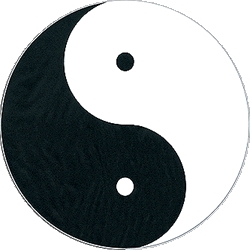
 One example that explicates the Syzygy takes its lead from the Yin-Yang School of Chinese philosophy. We start with a figure familiar to almost everyone: the Tai Chi symbol. This consists of a duality of Black and White—the colors of Yin and Yang—woven in a circle. More importantly, however, thanks to the small dots of opposite color inside each of the two main colors, the duality of the oppossing colors is also a complementarity: each side completes the other. Thus, the Tai Chi symbol is a Duality in Unity: a Syzygy. One example that explicates the Syzygy takes its lead from the Yin-Yang School of Chinese philosophy. We start with a figure familiar to almost everyone: the Tai Chi symbol. This consists of a duality of Black and White—the colors of Yin and Yang—woven in a circle. More importantly, however, thanks to the small dots of opposite color inside each of the two main colors, the duality of the oppossing colors is also a complementarity: each side completes the other. Thus, the Tai Chi symbol is a Duality in Unity: a Syzygy.
 The Tai Chi Tu has long served to express the most important concept in much of traditional Chinese philosophy: the Polarity of Yin and Yang. And in fact this figure also nicely illustrates the concept of Complementarity: apposite opposition. At this point, however, the figure is only finite; but the physicists' Void is potentially infinite, in order to provide the necessary resources for the more-or-less unrestrained generation of novelty. In order to represent this, then, the Syzygy itself must be some kind of Absolute Infinitude. And in order for the Tai Chi symbol itself to do justice to the idea of the Syzygy, the symbol itself should express this infinitude. We must thus make one modification to the Tai Chi symbol, one that will give it the necessary characteristic to illustrate this infinite aspect. We must, that is, replace each of the dots in the original symbol with a replica of itself, and then in these new little Tai Chi symbols we do the same thing, and so on, infinitely. In this way, we acquire a more powerful model of the Syzygy, one that includes both the underlying themes of complementarity and infinity at once. The Tai Chi Tu has long served to express the most important concept in much of traditional Chinese philosophy: the Polarity of Yin and Yang. And in fact this figure also nicely illustrates the concept of Complementarity: apposite opposition. At this point, however, the figure is only finite; but the physicists' Void is potentially infinite, in order to provide the necessary resources for the more-or-less unrestrained generation of novelty. In order to represent this, then, the Syzygy itself must be some kind of Absolute Infinitude. And in order for the Tai Chi symbol itself to do justice to the idea of the Syzygy, the symbol itself should express this infinitude. We must thus make one modification to the Tai Chi symbol, one that will give it the necessary characteristic to illustrate this infinite aspect. We must, that is, replace each of the dots in the original symbol with a replica of itself, and then in these new little Tai Chi symbols we do the same thing, and so on, infinitely. In this way, we acquire a more powerful model of the Syzygy, one that includes both the underlying themes of complementarity and infinity at once.
|

